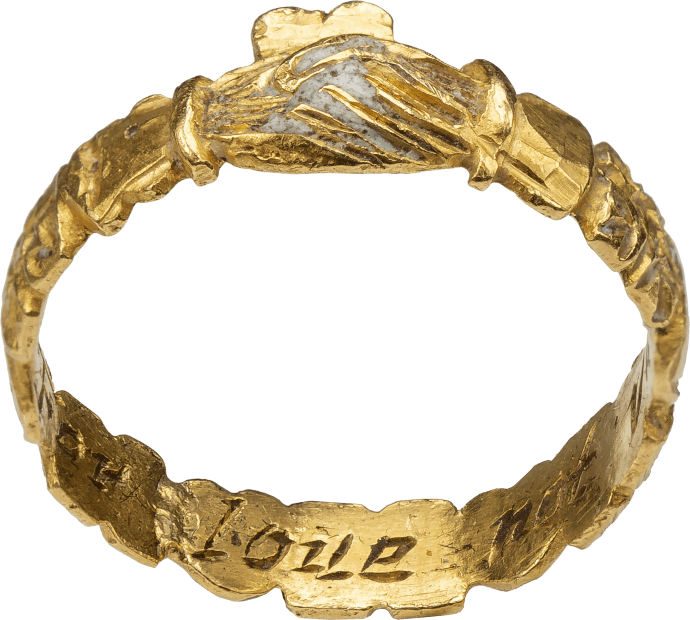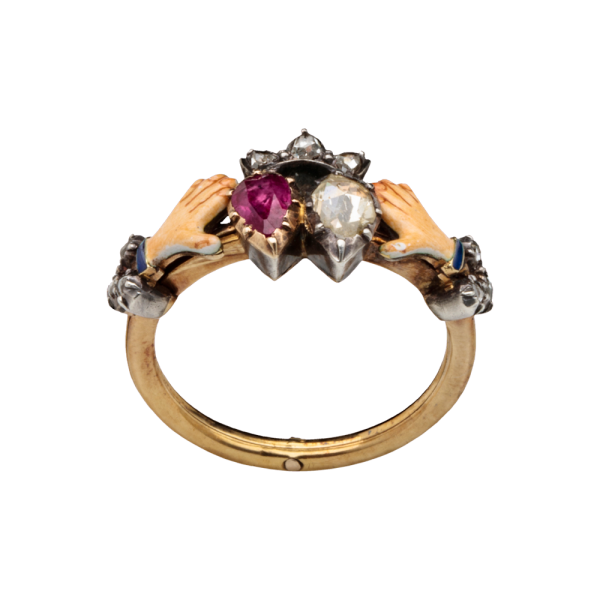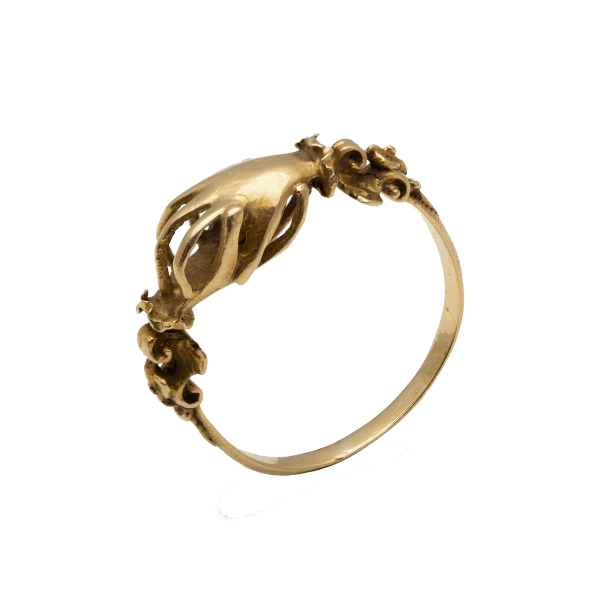


Fede Ring with Heart
, England, 17th century


Fede Ring with Heart
Description
Elaborately decorated posy ring, with messages of love and affection
Gold band, flat on the interior, chased and engraved on the exterior with alternating hearts and rosette motifs. The centerpiece shows two cuffed right hands clasped together holding a heart. Inscribed inside the band in italic script: ‘For love not valer’. Traces of enamel have survived. The ring shows signs of wear through age and is in good wearable condition.
The maker’s mark in rectangular punch inside the hoop has the initials ‘SW’, slightly indistinct due to the punch within the curvature of the hoop.
Literature:
Messages of romantic love on jewelry, and mottoes or inscriptions on plain gold bands go back to the Middle Ages. Beginning in the thirteenth century, ring brooches and rings were given as love tokens and the language of love was expressed in words and amatory motifs.
Each element of this ring expresses love and affection, as well as the union of marriage. The clasped hands or ‘mani in fede’ (Italian term for hands in faith), is a motif derived from the Roman ritual of the joining of the right hands during the betrothal ceremony known as dextrarum iunctio. The right hand was considered to be sacred to Fides, the goddess of trust and good faith. The clasped hands as a symbol of love and marriage has continued in both the ceremony and rings through the centuries, even today, see: Chadour-Sampson/Hindman 2016, nos. 20-1 for gimmel fede rings, and about the ritual Chadour-Sampson, Beatriz. The Power of Love, Jewels, Romance, Eternity, Unicorn, London, pp. 15 ff.
The alternating hearts and rosettes underline the love message concealed inside the hoop ‘For love not valer’, only to be known by the giver and recipient. The posy declares that the bond of love is more important than wealth. For similarly ornate examples of posy rings with clasped hands motif, cf. two examples in the Griffin Collection (Scarisbrick 2021, nos. 40, 63) and for the ring type Lindahl 2003, no. 258.
This fede ring is also a highly elaborate form of posy ring, which are usually simple gold bands with inscription. ‘Posy rings’, their name deriving from the term poésie or poetry, are rings with mottoes either in prose or verse. They find mention in plays by William Shakespeare, such as Hamlet and the Merchant of Venice and throughout the seventeenth and eighteenth centuries posy rings enjoyed great popularity. These were traditionally exchanged between friends, relatives and lovers, or given as betrothal or wedding rings.
For a history of posy rings with extensive examples ranging from the medieval period to the eighteenth century, see: Scarisbrick 2021 and further information on posies: Evans, 1931; Anon., A Garland of Love: A Collection of Posy-Ring Mottoes, London 1907; Dalton 1912, pp. 174 ff.; Scarisbrick 2007, pp. 74 ff., Taylor and Scarisbrick 1978; Oman 1974, pp. 39 ff.

